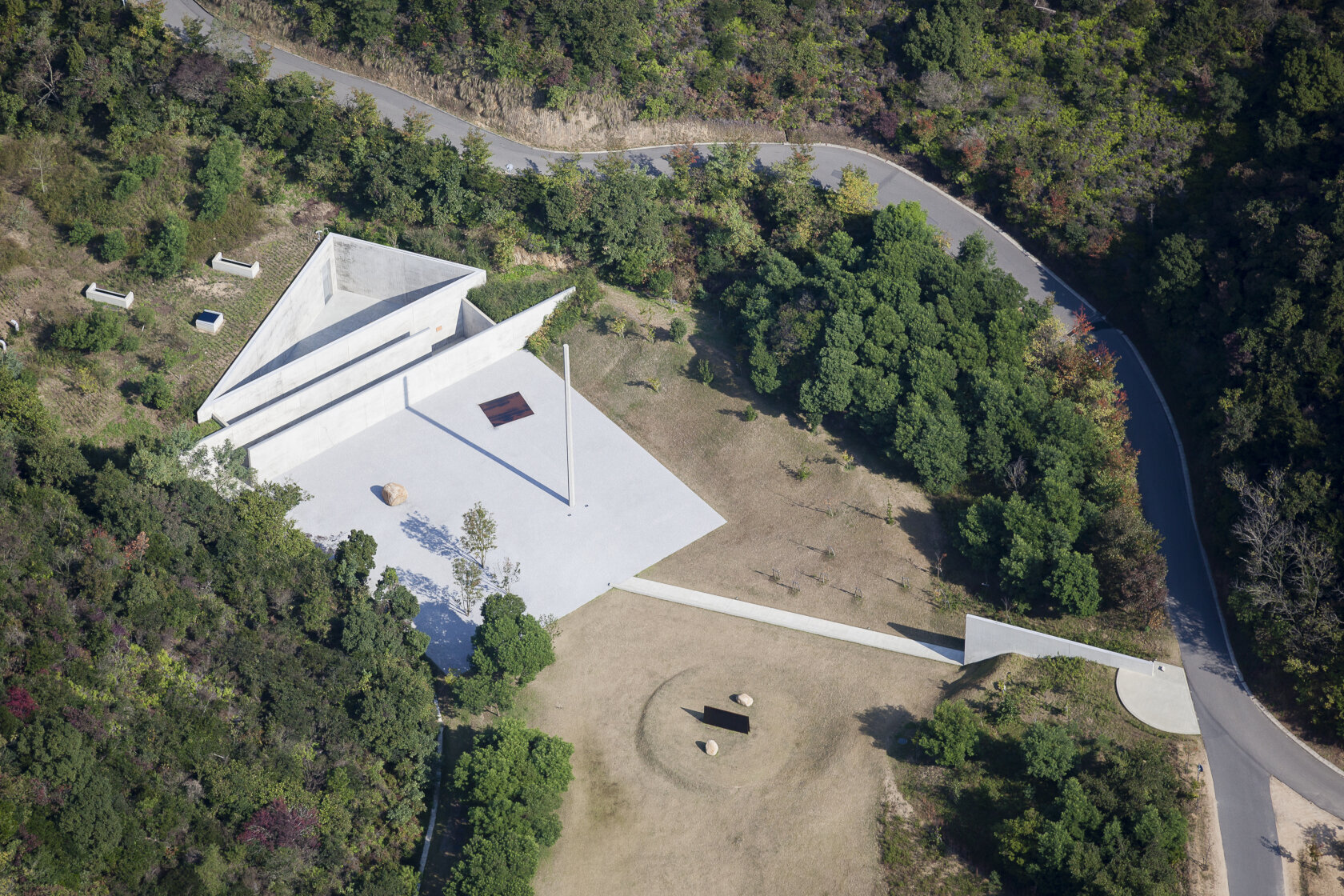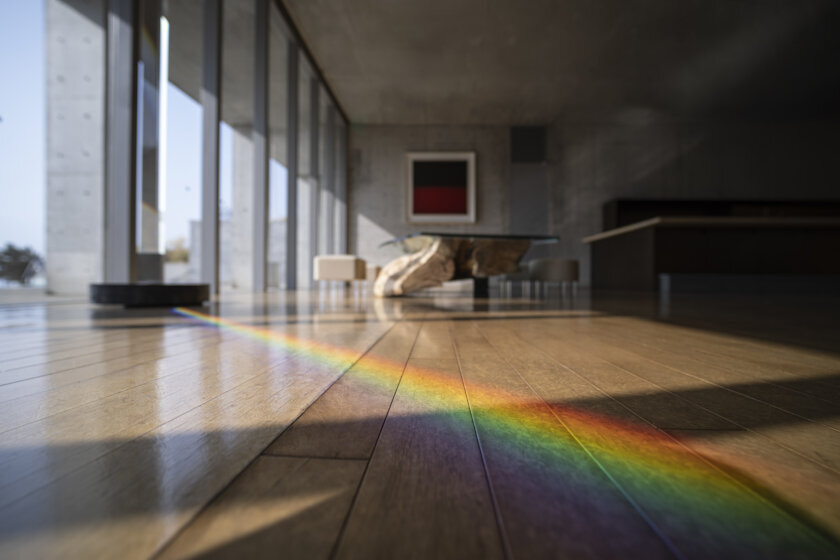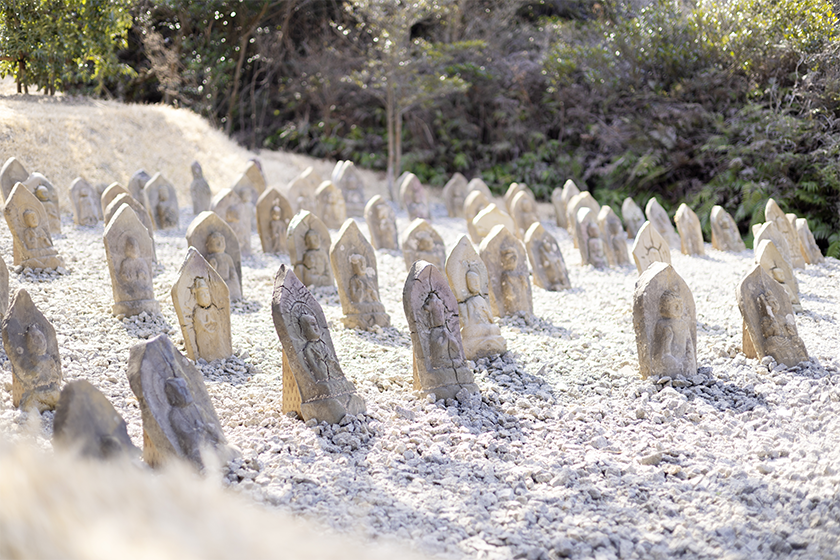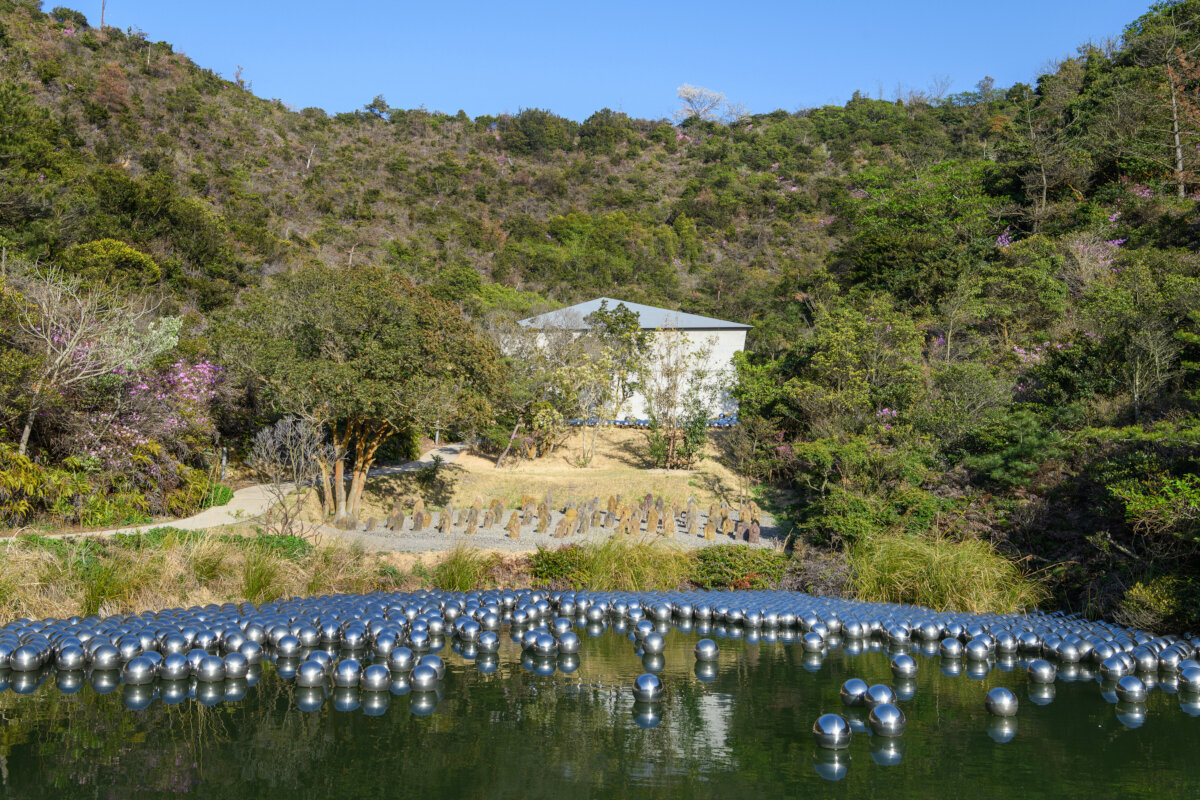Lee Ufan: Outward-bound Spirit / The Road Towards Infinity (#2)
To Europe, and to the World
While Mono-ha attracted attention around 1968 onward, Lee came to feel somewhat constrained and challenged by criticism as the group was often ridiculed for "not creating anything and simply bringing things and laying them down." He went to Europe for the first time with other Mono-ha artists to participate in the 7th Paris Youth Biennale in 1971.
This Biennale, the first opportunity for Mono-ha artists to show their works in Paris, was launched by Andre Malraux, the first Minister of Culture of France who intended for Paris to regain the position of being at the center of art which had been overtaken by New York and London. Unlike the Venice Biennale and the São Paulo Biennale, it focused only on young artists. With its innovative direction, the 1971 edition of the event included exhibitions of particular trends, questioning the model of exhibitions according to nation countries.
It was on this occasion that Lee encountered artists of movements such as Supports/ Surfaces from France and Arte Povera from Italy, who were inquiring how artists could reflect social realities in the momentum of social reformation movements that spread globally in the second half of the 1960s and aiming to rethink the basics of sculpture, such as the substantiality of materials and the relationship between an object and space. He also saw a retrospective exhibition of Barnet Newman in the U.S. on his way home. These experiences made a great impact on his works afterwards.
As Lee held exhibitions overseas in Paris and Germany and as the number of shows of his work gradually increased, he visited Europe every year from 1973, the year he first showed his painting series, From Line and From Point, while teaching classes at Tama Art University. In 1977, he exhibited his drawings at Documenta 6, a major international exhibition in Germany, and had solo exhibitions in 1978 at museums in Dusseldorf, Germany, and Denmark. Since the mid 1980s, he came to spend half or even two thirds of the year in Europe.
Lee spent more time working in Germany at first but then moved to France and set up his studio in Paris. While his experiences in Germany convinced him of the importance of humanities in artistic conceptualization, for he had first studied German philosophy when he was young, Paris was simply quite comfortable for him to stay.
Of course, it was not only because of good food and wine, but also because there were more foreigners in Paris, unlike Japan. As the "Revival of Ecole de Paris" Malraux sought for aimed at the promotion of artists from France and foreign countries alike, France had nurtured a culture that accepted a wide variety of artists regardless of their home countries or deficiency in French.
The cultural policies of France aiming to enhance the diversity, depth, and strength of its culture by assimilating cultural others seem to resonate with Lee's attitudes toward his creative activity.
Furthermore, not only the Centre Pompidou, which opened in 1977, but also Parc de la Villette and Musée d'Orsay were established in Paris, and many art museums and art centers followed across France, such as CAPC Musée d'Art de Contemporain Bordeaux and the galleries of the Regional Foundation of Contemporary Art developed under the decentralization policy of France. Under such circumstances, the opportunities for artists rapidly increased.
In such an environment, Lee won over many followers, while some regarded him as a mere "Oriental" artist in a stereotyped manner. He held a solo exhibition at Galerie Nationale du Jeu de Paume in 1997 as the first Asian artist to have a solo exhibition in a national institution of France.
Interestingly, the director of Galerie Nationale du Jeu de Paume who organized the exhibition was Daniel Abadi, who was one of the assistants to the general director of the 7th Paris Youth Biennale in 1971. The other assistant, Alfred Pacquement, would organize the large-scale solo exhibition of Lee's work at the Palace of Versailles in 2014.
Although having kept a certain distance from the United States for a long time, Lee and Mono-ha are evaluated highly in the U. S. market as well in recent years, with works exhibited frequently. The Solomon R. Guggenheim Museum held a solo exhibition in 2011. Lee's working fields expanded, encompassing Japan, Europe, Korea and the U.S.
Over the years in Europe, Lee became aware that strength was necessary in his work. As he continued his practice, he further came to pursue cross-border openness, instead of dismissiveness, which embraces and coexists with various qualities such as classicalness and persistence, and impurity and inconsistency. In other words, he looked to universality that offers timeless forms or something that appears different every time one sees it--something like the force of life.
In painting, Lee's brushstrokes changed from regular, repeated ones to irregular ones over the years from the 1970s to the 1980s. The Correspondance series he began in 1991 features a few flat brushstrokes and large blank backgrounds. In 2004, he started wall paintings drawn directly on the wall of the gallery space. His sculptures also changed, having been deconstructed and scattered across the space activating the relationships between different elements. As his style thus changed in various aspects, the scale of his work expanded.
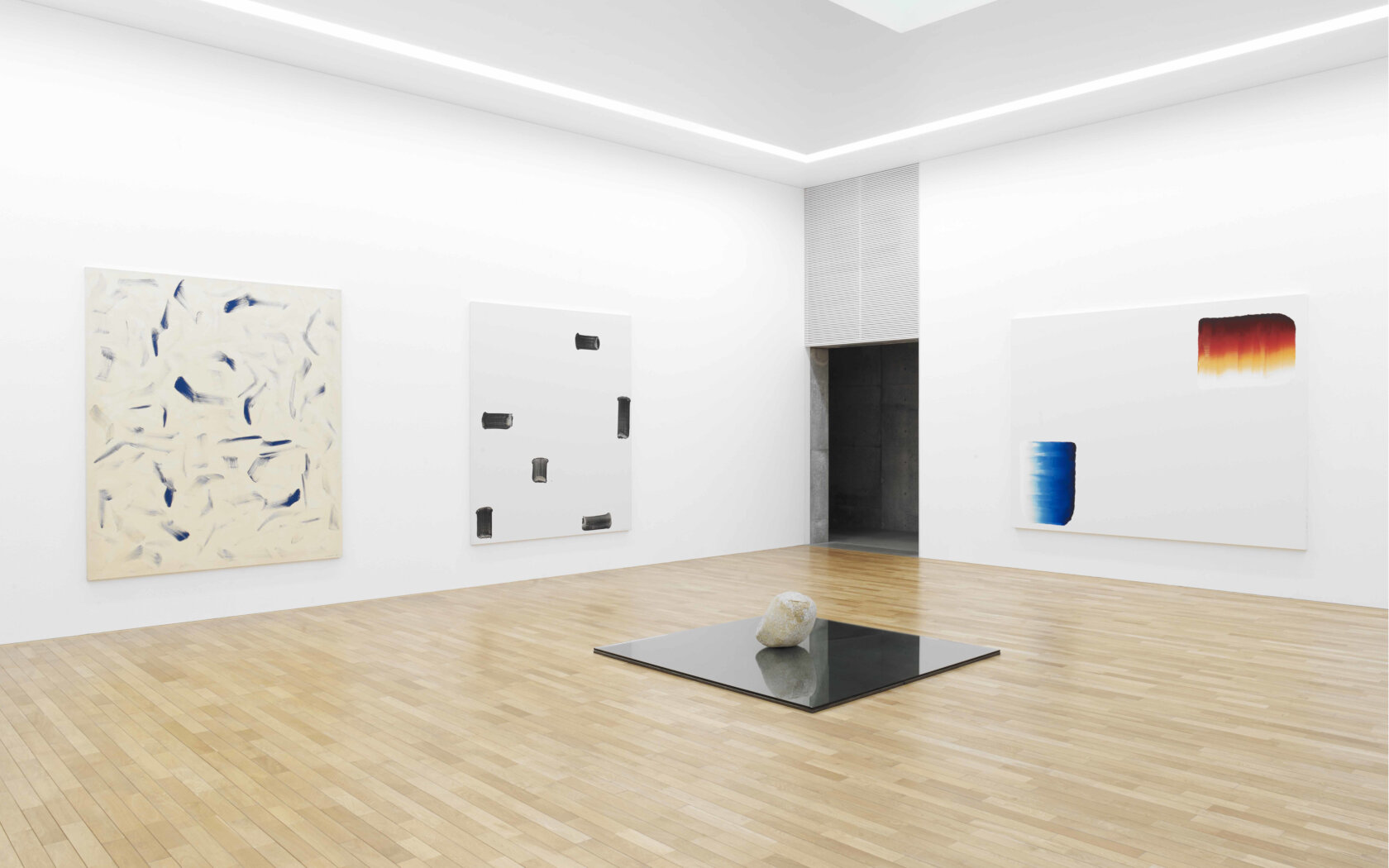
Beyond Objects
Compared with today when dismissiveness is not apparent, the 1960s was a time of global unrest with the Great Cultural Revolution in China, May 1968 in France, and college disturbances in Japan, and when given systems and values were denied. As Lee recollects, his stance traces back to that period of time when he could convert such resistance into his own power and resilience, which served as a departure point after denying the acts of painting and making.
Lee grew up in a household that believed a decent man should make a great achievement in academic world or politics. Since he focused on literature and had not received any kind of formal art education at all, becoming a painter was out of the question. Becoming engaged in social movements to have a connection to society while experiencing complexities about musical talent, he was continuously involved in art inquiring whether it was the right way for him or if there was an alternate way.
In the long run, however, Lee found that visual art involves all the five senses and perceptions other than visual one. He says, only in the last ten years or so, he has come to accept positively what he did incoherently and aimlessly as he wanted when he was young.
He has always been outbound. His journey so far has been that of an outsider and it has helped acquiring an attitude seeking to transcend the established ways of seeing and stances however tough and difficult it was.
"Since I used to be rejected to show my works because I was regarded as an invader in Japan and a fugitive in South Korea, I could not go either way. Then I went to Europe to find a place where I could live, but once I became famous, I was considered as an Asian. What I learned was that there was nowhere for me to belong. Then I began to inquire if I could make use of my 'minority' status in a positive and dynamic way; and if I could consider that I belong everywhere instead of that I belong nowhere. I decided not to think that I should belong to some place. As I thought so, I became used to double and triple ways of my being."
Lee has also commented:
"Although I do not have a specific religion, I believe that I co-exist with various beings. In Japan and Korea alike, we are animistic, believing that the living and the non-living are present together. I naturally became convinced of this as I worked and traveled around the world. Now I can practice a way of life without being stuck in small things like a particular race or country or whatsoever, and yet live with these matters as they are."
Porte vers l'Infini in Naoshima
In April 2020, when we were still in the state of emergency due to the Covid-19 pandemic, Lee Ufan issued a message.*3 He warned us about the homogeneity of globalism, egoistic nationalism, the recklessness and danger of individualistic laissez-faire attitudes, pointing out that these tendencies were caused by the modernist disposition to construct and expand a closed interior dismissive of the external.
Also, he expressed his concern about the rapidly increasing use of AI and robots during the pandemic leading to the belittlement of physicality, inquiring if human beings could become awaken to the interrelationships within the living world, restore their externality, and revitalize their civilization by having dialogs with nature.
In the previous year, Lee's sculpture Porte vers l'Infini had been completed in the beach-front yard of Lee Ufan Museum in Naoshima, which has a worldwide reputation as one of Lee's sculptural masterpieces permanently installed outdoors. When I read his message, I thought that this work was an apparatus to remind human beings of the problems Lee discussed. And I was convinced that it was necessary for the world's first museum dedicated to Lee's works, including this particular sculpture, to be created on Naoshima.
*3 Lee Ufan, "The Message of the New Coronavirus," April 22, 2020. (Tr. by Ashley Rawlings) Website of SCAI THE BATHHOUSE
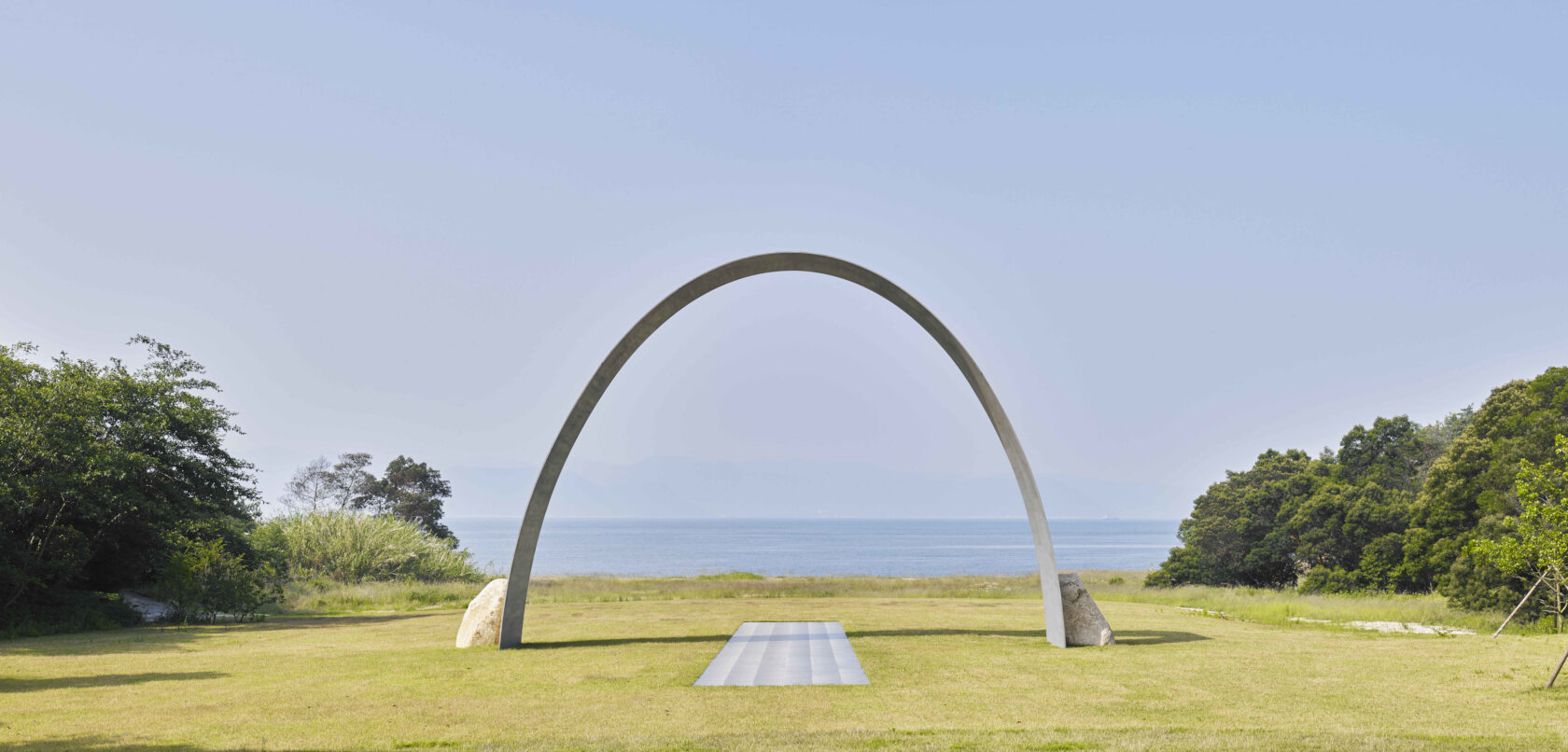
Lee conceived Porte vers l'Infini as something memorable for those who visit Naoshima via long-distance trips. It is situated in nature outside of the building of Lee Ufan Museum like a cave in the mountain which is somewhat reminiscent to the artist of his homeplace. He designed the form inspired by his old memory of a rainbow he saw over three decades ago.
Consisting of a 25 x 3 m stainless steel sheet laid on the ground, an arch made of exactly the same dimensions and material of the sheet, and a pair of natural stones placed as if supporting the feet of the arch, the sculpture brings tension and balance to the place, revitalizing the movement of the air in the entire valley as if fastening the sea and land, and the nature and museum's space. As visitors walk around and under the arch, the sculpture may reawaken their bodily senses, allowing them to feel connected to the land and the infinity of the universe and encounter a new world.
Lee has always moved outward like a nomad crossing many bridges and walking under many gates, having exchanges with other cultures and getting involved with the world. He has acquired dynamic power out of the tension, balance and mutual relationships between diverse things. As if reflecting both his personal history as such and the history of the islands in the Seto Inland Sea, which have survived by being open outward through maritime transportation while remote from the central power, the sculpture erects in nature.
Walking under the arch facing the blue sky and sea and breathing deeply in the windy air through the unmasked nose and mouth, not only myself but also many other people will feel we are part of the great nature and convinced that our personal lives, islands, and local communities can be revitalized time and time again.

This essay is based on direct conversations with the artist unless otherwise noted.
List of other references:
Okyang Chae-Duporge, "Chronology", Lee Ufan Museum , the Fukutake Foundation, 2015. 118. "Oral History Interview with Lee Ufan", interviewed by Yasuyuki Nakai, Kenji Kajiya, July 20, 2009, renewal December 23, 2012.
https://oralarthistory.org/archives/lee_u_fan/interview_01.php (Japanese only)
"Record of Artist Talk on June 4, 2010 at Lee Ufan Museum" 2010 (Non-public material of the Fukutake Foundation)
Benesse Art Site Naoshima's blog of March 3, 2017. (Japanese only)
Benesse Art Site Naoshima's blog of December 11, 2020.
"Lee Ufan Interview: To Encounter the Infinity of the Universe and Self", Benesse Art Site Naoshima, October 2019, 2-9.
Akiko MikiBenesse Art Site Naoshima International Artistic Director / Director, Naoshima New Museum of Art (Open in Spring 2025)
Former Chief and Senior curator, Palais de Tokyo (2000-2014), Co-director, Yokohama Triennale 2017 and Artistic Director of its 2011 edition among others. She was also guest curator for many large-scaled exhibitions including the ones of Japanese artists such as Nobuyoshi Araki, Hiroshi Sugimoto, Takashi Murakami at major museums in Asia and Europe as Barbican Art Gallery, Taipei Fine Art Museum, National Museum of Contemporary Art, Seoul, Mori Art Museum, Yokohama Museum of Art, and Kyoto City KYOCERA Museum of Art.

